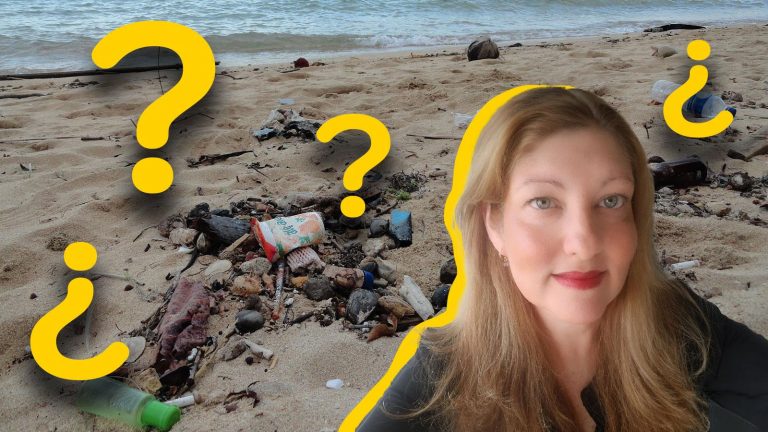A reader asked us:
What can be done to reduce the amount of plastic in the ocean, i.e. how can at least some of it be removed from the ocean, and what plastic can be recycled in the future?
We asked YCC contributor Johani Ponce to find the answer to this question. This is his answer:
Plastic pollution in the ocean is a serious environmental problem that affects not only marine life, but also the health of communities and the planet. Studies estimate that there are 15 to 51 billion pieces of plastic in the world's oceans, from the equator to the poles, and from the Arctic ice caps to the seafloor. There is barely a square mile of ocean surface on Earth that is not contaminated by plastic.
The production of plastics begins with the extraction and refining of raw materials such as oil and natural gas, from which monomers are obtained and converted into polymers through a polymerization process. These polymers are combined with additives to improve their properties and then molded into the final product through techniques such as injection or extrusion.
The plastics industry contributes significantly to greenhouse gas emissions. According to the United Nations Environment Program, the production, use and disposal of plastics produced 1.8 billion tons of greenhouse gases in 2019, accounting for 3.4% of the global total. These emissions come from fossil fuel extraction, manufacturing processes and plastic waste management, including incineration, which releases additional carbon gas.
To meet this challenge, reducing the input of plastic into the ocean and eliminating plastic waste already present in marine ecosystems must be addressed simultaneously. In addition, it is crucial to find ways to effectively recycle plastic. Below we explain some key strategies to reduce and remove plastic from the ocean, and how to recycle it.
1. Prevention: Reduce the use of plastics
The most effective way to reduce the amount of plastic in the ocean is to prevent it from entering the ocean in the first place. This can be achieved through a range of actions at the individual and government levels:
- Reduce disposable plastic consumption: Single-use plastics, such as bags, bottles, straws and food containers, are the main culprits of plastic pollution. Choosing reusable alternatives, such as stainless steel bottles or cloth bags, can make a big difference.
- Push for legislation and policies to ban single-use plastics: Many countries and cities have begun to impose bans or taxes on single-use plastic products. These policies encourage a shift to more sustainable alternatives and reduce the flow of plastic into the ocean.
- Promote innovation in packaging and biodegradable products: Investing in research and development of alternative materials such as biodegradable or compostable plastics can reduce the need for traditional petroleum-based plastics, which are the most harmful to the marine environment.
2. Clean oceans: Eliminate existing plastics
While prevention is crucial, millions of tons of plastic are already polluting the oceans, and several cleanup efforts are underway to address the problem.
- Ocean plastic collection technology: Similar projects ocean cleanup Technology has been developed to use floating fences to capture floating plastic in the ocean. These barriers concentrate plastics in one area, making them easier to collect. Such projects aim to clean up ocean “garbage patches” such as the Great Pacific Garbage Patch.
- Clean coasts and rivers: Many NGOs and volunteers participate in beach cleanups to prevent plastic from entering the ocean. Rivers are the main pathway for plastic from land to sea, so installing waste collection systems in rivers can intercept plastic before it reaches the ocean. One example is the Ocean Cleanup’s Interceptor project, which cleans up the world’s most polluted rivers.
- community initiative: Supporting coastal communities with regular beach cleans and promoting environmental education is also crucial. Many times, small-scale cleanups can have a big impact on protecting marine life and the health of coastal ecosystems.
3. Marine plastic recycling
Once plastics are removed from the ocean, it is crucial to find efficient ways to recycle them and reuse them, rather than simply throwing them away.
- chemical recycling: Due to the wide variety of plastics and many impurities in marine garbage, traditional plastic recycling is very complicated. Chemical recycling is an emerging technology that breaks down plastics into their basic chemical components, allowing them to be reused to produce new plastic materials. Companies such as Plastic Energy are developing such technology.
- circular economy: The idea behind the circular economy is to maximize the life of materials, including plastics, and minimize waste. Some companies are using recycled ocean plastic to make new products, such as clothing, shoes and furniture. Adidas, for example, has launched a line of shoes made from plastic collected from the ocean.
4. Education and Awareness
Ultimately, no solution will be effective in the long term without changing people’s mindsets and spending habits. Environmental education and awareness programs in schools, companies and communities can help reduce the demand for plastic and promote greater personal responsibility in waste management.
